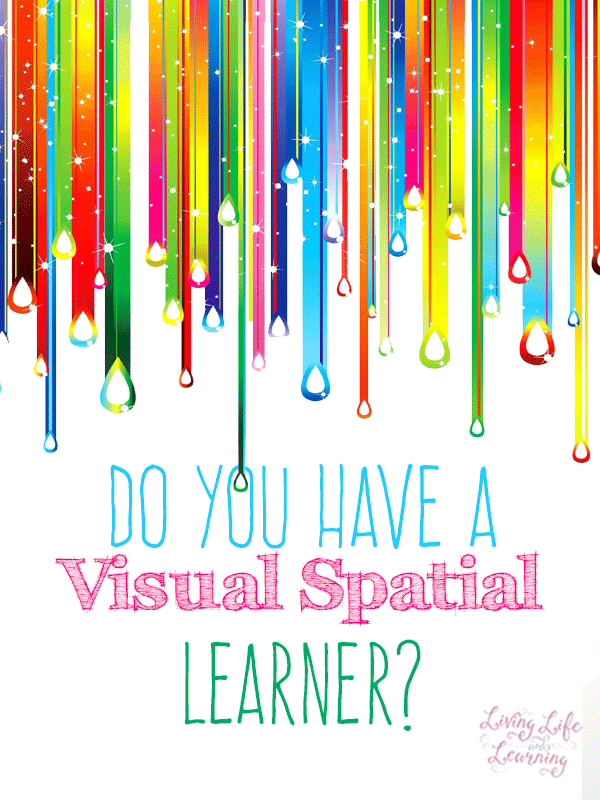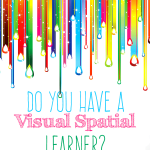Do you have a Visual Spatial Learner?
If you haven’t figured out what type of learning style your child has then I suggest you do that right away. I discovered that I had a visual spatial learner.
After a completely random email from Currclick.com as well as reading everything I can from VisualSpatial.org, I have finally found my son’s learning style. This is the quiz I read from the email and answered yes to 16/19 questions.

- Does your child seem to intuit and care about the feelings of others?
- Does your child tend to forget what you tell him?
- Does he seem to recall well what he sees?
- Does she frequently lose track of time?
- Does he seem talented in art, music, dance, or drama?
- Does she seem disorganized?
- Does he have trouble with spelling?
- Does she have trouble remembering phonics and math rules?
- Does he seem to remember how to get places he’s only been to one time?
- Does your child like to construct things?
- Does she like to figure out how things work (taking them apart?)
- Does your child frequently visualize things? Example: does he frequently see one thing and say “Oh, that looks like a _____________” ?
- Does he start laughing during a conversation because a combination of words reminded him of a funny picture in his head?
- Can she solve a problem without being able to tell the steps she took to get to the solution?
- Is your child good at puzzles or mazes?
- Does your child solve problems in unusual ways? In other words, once you tell him what the goal is, does he arrive at that goal in unexpected ways?
- Does she have a vivid imagination?
- Does your child prefer to draw you a picture or diagram of what he’s thinking then try and tell you using words?
- Does your child have at least one parent that would answer “yes” to most of the questions above?
If this sounds like your child, it is likely he or she is a visual-spatial learner.
*Questions based on a quiz from Golon, A. S. (2004). Raising Topsy-Turvy Kids: Successfully Parenting Your Visual-Spatial Child. Denver: DeLeon Publishing.
I’ve put a hold on Upside-down brilliance: The visual spatial learner by Dr. Linda Silverman at my library which is essentially a textbook on VSLs and how to teach them, I can’t wait to read it.
As far as I know from what I have read, VSLs mostly use the right side of their brains, as opposed to auditory sequential thinkers who use the left side of their brain.
Characterisitics of Visual Spatial Learners
- Think in pictures – remember what is seen and not heard
- Whole-part learners, forgetting small parts/details – don’t succeed with phonics, bad spellers
- Do not succeed with repetition or drills – difficulty memorizing math facts/timetables
- Learn concepts all at once
- Good with maps-know directions to a place after visiting once
- Difficulty with fine motor skills-bad handwriting, prefer keyboarding
- Disorganized and have difficulty with the concept of time
- Learn by seeing relationships
- Good long term visual memory
- Good at geometry and physics
- May solve complex problems but have trouble with simple ones
- Good at puzzles and mazes
- Like building, finding how things work, excel at art, drama, and music, good at computer games, and taking things apart and putting back together
This is my child, they may also be perfectionists and do not like to work through trial and error, this explains so much. M1 must ask if each math question is correct before moving on. I now must reconsider everything we’ve been using as curriculum. I’m going to stop spelling and phonics until I read more on this.
The lapbooks for history and science have been going really well and he has stated these are his favorite subjects as well as our timeline. VSL can be very sensitive and that is definitely M1.
I look forward to reading all I can on this, it’s really given me more direction with his learning. I always knew he was a visual learner and I’ve always given him lots of manipulatives for math, but he has started to do things mentally, which has taken awhile.
I was wondering why he could recite every Spongebob episode he’s seen word for word but can’t tell me what happened from a story that I read aloud of 3 paragraphs. VSLs can be easily distracted but can focus on things completely once they are interested, who doesn’t.
I don’t believe in placing labels on children but this description of a VSL is MY child. I hope to use it to change things that I’m teaching at home to better suit his needs. Ideally, I’d like to have a psychoeducational assessment done but is way out of my budget.
When we’ve read aloud, M1 has always followed along with me, however, he can sit and listen to magic tree house audio books no problem, anything else is a challenge.
I’m looking to switching to Megawords for spelling and not sure what to do about phonics at this point.
(edited April 2019)
The workbook style of Megawords did not work out for him and we started at the beginning with All About Spelling and he loved using the tiles rather than writing out his spelling words.
Science and history will stay the same. I will also need to use more pictures to go along with his writing for narrations. I also think I will start him on typing soon as well.
Other helpful sites for visual spatial learners
Here are some great books about VSLs if you’re not familiar with this term, or if you find that you may have a VSL in your homeschool.
Books about Visual Spatial Learners
- How to get your child off the refrigerator and onto learning (Barnier)
- The Way they learn (Tobias)
- Every child can succeed (Tobias)
- Unicorns are real: A right brained approach to learning (Vitale)
- Right brained children in a left brained world (Freed)
- Upside down brilliance: The visual spatial child (Silverman)
- Raising Topsy-Turvy kids: Successfully parenting your visual spatial child (Golon)
- Visual-Spatial Learners (Golon)
The book by Silverman was a really good read, it was like a textbook written about my child. My son is an introverted VSL content in his own world. He doesn’t like change and needs advance notice when events may change, he’s sensitive to loud noises, and is very sensitive himself. The books also gives teaching strategies to use as well. I have compiled a list of curricula being used by homeschool moms from the well trained mind forums, who are also teaching VSLs (I tried to choose links with samples).
Visual-Spatial Learners




Best Homeschool Curriculum for Visual Learners
Phonics
- All About Spelling
- Spell to Write and Read
- Pathways phonics
- Explode the Code
- Jolly Phonics
(this is how my son learned to read in school)
- Reader Rabbit software
Spelling
Vocabulary
Grammar
- Primary Language Lessons
- Junior Analytical Grammar/Analytical Grammar
- Winston Grammar
- Ridgewood grammar,
- School House Rock videos
- Grammar Land
- Ruth Heller grammar books
- The Sentence Family
- Mad libs
Writing
- Classical writing
- Wordsmith Apprentice
- Jump in
- Junior English from Galore park
- Michael Clay Thompson (grammar, vocab, writing and poetry)
- Learning Language Arts Through Literature
, copywork and narration
Math
- Right start
- Singapore
- Miquon
- Teaching Textbooks
- Math u see
- Math mammoth
- Times tales
- Life of Fred
- Key to series
- Hands on equation
Science
- Apologia and God’s design sciences
- Singapore My pals are here
- My world science
- A cartoon guide to series (genetics, chemistry…)
History
- Story of the world
+ the activity guide, Evan Moor history pockets and Horrible Histories
Unit studies and Lapbooks
- Five in a row
- Hands of a Child
- Journey Through Learning
The Curious Kid’s Science Book: 100+ Creative Hands-On Activities for Ages 4-8




Remember what works for one family may not work for yours. It also depends on how you use it as well. I use Saxon math which is not on the list which works really well for my ds. We switched over from Math u See which is on the list because it was too repetitive.
He still uses the blocks a lot, they’re great. We do the meeting but he completes one side of the worksheet and I stopped doing the drill sheets, anything that is so repetitive is just torture for him.
Usually, VSLs have difficulty learning to read because they are usually taught to do so through phonics. M1 was in public school when he learned to read and his teacher said that she didn’t know how he decoded words, he just knew them. I figure all the reading we did as toddlers every night paid off. They usually learn through whole word recognition and do poorly with phonics.
Languages are usually learned best by immersion, I use L’art de lire for French, but we also read small french books and signs/cereal boxes, whatever we can find.
In the book Upside down brilliance Silverman found a correlation between VSLs and late talkers, not saying that all late talkers were going to be VSLs but that a majority of VSLs were late talkers. M2 is really blossoming now at 2 1/2 years old, perhaps he will turn out to be a VSL as well, although he is definitely a more social bee.
In terms of curriculum, VSLs learn best without workbooks, they learn by looking at the whole picture first then looking at the details. Anything that tells a story or is humorous goes over really well. Anything that you choose must be visually appealing but not distracting and hands on.
Any science curricula should work as long as you are taking the time to do the experiments. History should be completed with mapwork, timelines, and activities so that they retain it.
I love lapbooks for that, although I started using them since another homeschool mom I knew recommended them, before I knew M1 was a VSL.
These are some other items that could be implemented into your homeschool:
- Short lessons
- Lots of manipulatives
- Computer games
- DVDs for science (Bill Nye and Magic School bus) and history documentaries
- Lapbooks
- Timelines
- Notebooking
- Graphs and charts
- Flow charts, graphic organizers, and concept maps
- Legos/Kinex
- Snap circuits
- DK eyewitness books (M1 loves these)
- Graphic novels
- Puzzles/games
Animal Locomotion























